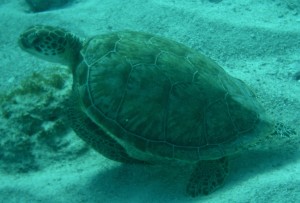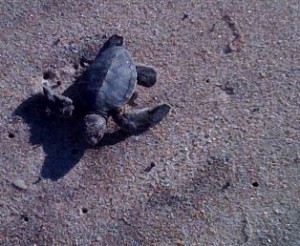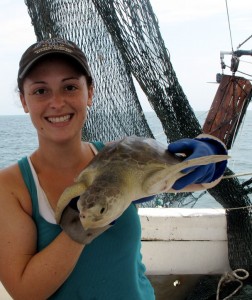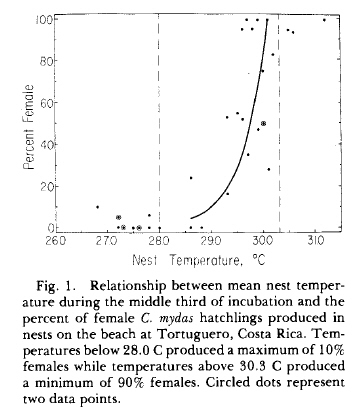 When most people think of an animal threatened by global warming, images of a polar bear drowning because of lost ice habitat come to mind. Few know that climate change can also threaten animals used to living in environments much warmer than the Arctic. Even when you’re used to heat, too much heat can be a serious problem- particularly in vulnerable early life history stages.
When most people think of an animal threatened by global warming, images of a polar bear drowning because of lost ice habitat come to mind. Few know that climate change can also threaten animals used to living in environments much warmer than the Arctic. Even when you’re used to heat, too much heat can be a serious problem- particularly in vulnerable early life history stages.
One example of this phenomenon is the sea turtle. Though one species (the leatherback) often ventures into Arctic waters, the other species are largely confined to tropical and temperate climates. All seven species are threatened or endangered due to decades of bycatch mortality and habitat destruction, and they are in serious trouble as a result of warming beach temperatures.

Unlike humans, where gender is determined by chromosomes (two X’s makes you a female, an X and a Y make you a male), many reptiles have their gender determined by temperature. Incubating eggs in relatively cool sand results in male hatchlings, and incubating eggs in relatively warm sand results in female hatchlings.
- Figure from Standora and Spotila 1995
Rising temperatures are already resulting in a greater number of female sea turtles and a smaller number of males. In Florida in the 1980’s, 90% of the loggerhead sea turtle hatchlings were female (up by me in South Carolina, the numbers were closer to 50/50). In the grand scheme of things, it is probably better to have more females than males, particularly since males can mate every year and females cannot. However, a complete absence of males presents a serious problem for the species, and if current trends continue, that isn’t out of the question. To make matters worse, something else appears to be happening to sea turtle populations in the meantime.

On-the-beach hatchling sex ratios these days are, on average, about 6:1 female to male. However, wild populations of juvenile turtles have an approximately 2.5:1 female to male ratio. While some scientists believe that many females just go elsewhere to develop, others believe that millions of female hatchlings aren’t surviving to become juveniles.
As it turns out, the temperature-dependent sex determination story may be incomplete. Relatively cool sand produces males, relatively warm sand produces females, but extremely warm sand results in eggs that hatch much more quickly (and may have development problems because of this rush). Climate change isn’t just resulting in many more female turtles, it may be resulting in weaker turtles.

Determining if warmer-incubated turtles have lowered fitness will be the thesis of Leah Fisher, a good friend of mine. She is considering starting a sea turtle conservation blog, and I’ll be sure to keep everyone posted as events unfold, but in the meantime she agreed to answer some of my questions about this issue.

WhySharksMatter (WSM): How did you get interested in working with sea turtles?
Leah Fisher (LF): I’ve always wanted to be a marine biologist, but while at Duke during my sophomore year I was exploring molecular research in an attempt to mediate my parents’ desire for me to go to medical school. That summer I went to the Duke Marine Lab and took Biology and Conservation of Sea Turtles with Karen and Scott Eckert, and never looked back.
WSM: What is your favorite thing about them?
LF: I think they’re really cool animals. They have a lot of physiological adaptations, and the differences between the species are interesting, but I think my favorite part is how they know exactly where they’re going when they’re swimming. They have such small brains, but essentially have built-in GPS systems to navigate entire ocean basins.
WSM: What is the evolutionary advantage of temperature-based sex determination?
LF: This is actually up for debate with many theories out there, but most scientists seem to think it’s either an evolutionary relic, or that having different sexes at different temperatures conveys some sort of unknown fitness advantage. So if males are born at cooler temperatures, they are more fit than females born at that temperature. Nobody really knows though.
WSM: Do any other animals have TSD?
LF: A lot of reptiles do, like alligators, and a few bird species too.
WSM: How do you plan on testing if warmer-incubated turtles have lower fitness?
LF: I’m going to try to get at overall fitness by looking at physical variables, locomotion, and behavior. Simple variables like length and weight may be informative, and I am also going to conduct a crawling and swimming test to look for differences in speed, locomotion patterns, and/or orientation.
WSM: With all of the threats facing sea turtles, are you optimistic about the future of these animals?
LF: Not particularly, but at least they’re charismatic megafauna so it’s easier to get the general public into conservation. I think on a whole, to save the oceans, we need a concerted global effort or a lot more things are going to go downhill.
~WhySharksMatter
Hanson, J., Wibbels, T., & Martin, R. (1998). Predicted female bias in sex ratios of hatchling loggerhead sea turtles from a Florida nesting beach Canadian Journal of Zoology, 76 (10), 1850-1861 DOI: 10.1139/cjz-76-10-1850
James, M., Andrea Ottensmeyer, C., & Myers, R. (2005). Identification of high-use habitat and threats to leatherback sea turtles in northern waters: new directions for conservation Ecology Letters, 8 (2), 195-201 DOI: 10.1111/j.1461-0248.2004.00710.x
Lewison, R., Freeman, S., & Crowder, L. (2004). Quantifying the effects of fisheries on threatened species: the impact of pelagic longlines on loggerhead and leatherback sea turtles Ecology Letters, 7 (3), 221-231 DOI: 10.1111/j.1461-0248.2004.00573.x
Standora, E., & Spotila, J. (1985). Temperature Dependent Sex Determination in Sea Turtles Copeia, 1985 (3) DOI: 10.2307/1444765

Charismatic megafauna! (That will be the title of my autobiography)
Never thought about it in terms of climate change before. Interesting. I wonder if komodo dragons have temperature dependent sex determination: the problem they’re having is the male/female ratio is weighted heavily towards the males. If their sex determination is temperature based, I wonder if we’ll see a boom in komodo dragon populations?
I’ll be on Web of Knowledge…
If any of your readers are in Long Island, the Riverhead Foundation does a 5k Run for the Ridley, and its coming up next weekend. http://www.riverheadfoundation.org/events/detail.asp?briefing_id=88
Very interesting. I think there was a paper within the last few years that suggested human sex ratios may be very slightly influenced by temperature… or latitude. And I would love to see a sea turtle conservation blog!